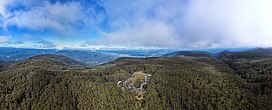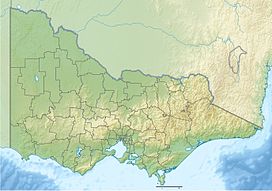| Mount Donna Buang | |
|---|---|
 Aerial view of Mount Donna Buang Aerial view of Mount Donna Buang | |
| Highest point | |
| Elevation | 1,250 m (4,100 ft) |
| Prominence | 470 m (1,540 ft) |
| Isolation | 10.4 km (6.5 mi) |
| Listing | List of mountains in Australia |
| Coordinates | 37°42′23″S 145°40′52″E / 37.70639°S 145.68111°E / -37.70639; 145.68111 |
| Geography | |
 | |
| Country | Australia |
| State | Victoria |
| Protected area | Yarra Ranges National Park |
| Parent range | Victorian Alps, Great Dividing Range |
Mount Donna Buang ("the body of the mountain" in the language of the Wurundjeri people) is a mountain in the southern reaches of the Victorian Alps of the Great Dividing Range, located in the Australian state of Victoria. Approximately 94 kilometres (58 mi) from Melbourne with an elevation of 1,250 metres (4,101 ft), Mount Donna Buang is the closest snowfield to Melbourne.
Location and features



In winter, it usually receives snow suitable for snow play and tobogganing, and during the non-winter months the area is well visited by bushwalkers and cyclists. The summit of Mount Donna Buang is surrounded by alpine ash (or woollybutt) trees and sub-alpine snow gums, and at nearby Cement Creek there is a canopy walkway through myrtle beech and mountain ash trees known as the Mount Donna Buang Skywalk.

Mount Donna Buang is part of the Yarra Ranges National Park (established in 1995). The nearest serviced town to the mountain is Warburton.
Flora and fauna

The lower and middle slopes of the mountain are characterised by very tall forests of mountain ash with a cool temperate rainforest mid-story on the southern slopes and sheltered areas elsewhere on the mountain. Trees such as myrtle beech, sassafras and soft tree fern as well as large shrubs like hazel pomaderris are fairly common in this zone. On the higher slopes sub-alpine species such as woollybutt and snowgum predominate, although myrtle beech is also common almost to the summit.
It contains a number of native mammals including the rare Leadbeater's possum, and is home to 120 species of native birds. Some examples include the pink robin, yellow-tailed black cockatoo, the crimson rosella and the rare lyrebird, heard to imitate chainsaws, motorbikes, and other species of birds.
The Mount Donna Buang wingless stonefly is endemic to the area. Mount Donna Buang is the type locality of the velvet worm Ooperipatus centunculus.
History


In the 1860s, “Mount Acland” was the name given to the 1,250m high mountain by a Police Magistrate called Joseph Anderson Panton. The name it has today, “Mount Donna Buang”, probably came from the Wurundjeri.
A walking track to the summit of Mount Donna Buang was cut during the 1890s and the much wider Donna Buang Bridle Track, which the current road from Warburton to the top of Mount Donna Buang follows, was opened in 1912.
Federal government minister Lee Batchelor suffered a fatal heart attack while climbing Mount Donna Buang in 1911.
Timber from the mountain was harvested from the early 1900s to the mid-1920s with seven cable-hauled tramways moving logs from the Ben Cairn - Donna Buang ridge down to sawmills near Warburton. While the forest has regrown and the mountain appears to have never been logged, relics such as tram rails and cables can still be found in the forest.
From 1925 to the early 1950s Mt Donna Buang was a popular ski resort. It had four ski lodges, day visitor shelters, cafes, a ski hire, a ski jump and six runs cut through forests of myrtle beech and woollybutt. For over 20 years it had thousands of visitors every weekend there was snow. However, the runs were fairly short and the snow cover was always erratic, so after the Second World War, better transport meant it lost out to higher ski resorts further from Melbourne, although the mountain remained popular with family snow play groups.
Cycling
The road from Warburton to Mount Donna Buang is a challenging cycling route, averaging a climb of 6.2% over 16.6 km and has also become a popular destination for recreational driving, motorcycling, and in the summer a challenging training route for endurance cyclists and triathletes.
The main public roads on Mt Donna Buang are:
- Donna Buang Road, sealed from Warburton to a bit past the Mount Donna Buang Summit Road junction.
- Acheron Way, joining Donna Buang Road about halfway up, leads to Marysville. It is sealed except for a 12-kilometre section in the middle.
- Don Road runs from Healesville to the Warburton Highway between Yarra Junction and Launching Place. It connects with Donna Buang Road, and is unsealed for much of its length.
 Panorama from summit of Mount Donna Buang
Panorama from summit of Mount Donna Buang
See also
References
- ^ "Mount Donna Buang, Australia". Peakbagger.com. Retrieved 5 June 2023.
- "Mount Donna Buang". eMelbourne - The Encyclopedia of Melbourne Online. The University of Melbourne. Retrieved 3 August 2024.
Located in the Yarra Ranges National Park near Warburton this 1250-m mountain, known to early European settlers as Mount Ackerley or Mount Acland, after the soldier Colonel Acland Anderson, now carries a rendition of its Aboriginal name, meaning 'the body of the mountain'.
- "Yarra Valley Directory". Archived from the original on 13 May 2007.
- Mount Donna Buang Wingless Stonefly (Riekoperla darlingtoni) – Unsuccessful listing advice
- Reid, A. L. (1996). "Review of the Peripatopsidae (Onychophora) in Australia, with Comments on Peripatopsid Relationships". Invertebrate Taxonomy. 10 (4): 663–936. doi:10.1071/IT9960663.
- Jaensch, Dean (1979). "Batchelor, Egerton Lee (1865–1911)". Australian Dictionary of Biography. Canberra: National Centre of Biography, Australian National University. ISBN 978-0-522-84459-7. ISSN 1833-7538. OCLC 70677943. Retrieved 3 October 2007.
- McCarthy, Mike. Mountains of ash: a history of the sawmills and tramways of Warburton and district. Light Railway Research Society of Australia, 2001. Chapters 3,4 and 6.
- Sisson, David (2015). "Donna Buang: the forgotten ski resort". Australian Mountains. Retrieved 3 August 2024.
- "Donna Buang". Cycling Profiles. 2012. Archived from the original on 13 March 2018.
- "Mt. Donna Buang | the Climbing Cyclist". 4 February 2022.
External links
- Donna Buang: the forgotten ski resort A history of Mt Donna Buang
- parkweb.vic.gov.au - mt-donna-buang-summit
- Warburton Valley official website
- Snow report
- WarburtonInfo Mt Donna Snow Info
- Tour of the Summit of Mount Donna Buang
- "Place ID 15429". Australian Heritage Database. Australian Government.
| Mountains in Victoria, Australia | |||||||||||
|---|---|---|---|---|---|---|---|---|---|---|---|
| Grampians | |||||||||||
| Victorian Alps |
| ||||||||||
| Other mountain ranges |
| ||||||||||